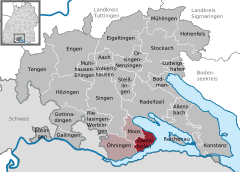Gaienhofen
| Gaienhofen | ||
|---|---|---|
|
| ||
| ||
 Gaienhofen | ||
Location of Gaienhofen within Konstanz district 
 | ||
| Coordinates: 47°40′59″N 8°58′56″E / 47.68306°N 8.98222°ECoordinates: 47°40′59″N 8°58′56″E / 47.68306°N 8.98222°E | ||
| Country | Germany | |
| State | Baden-Württemberg | |
| Admin. region | Freiburg | |
| District | Konstanz | |
| Government | ||
| • Mayor | Uwe Eisch (CDU) | |
| Area | ||
| • Total | 12.55 km2 (4.85 sq mi) | |
| Population (2015-12-31)[1] | ||
| • Total | 3,394 | |
| • Density | 270/km2 (700/sq mi) | |
| Time zone | CET/CEST (UTC+1/+2) | |
| Postal codes | 78343 | |
| Dialling codes | 07735 | |
| Vehicle registration | KN | |
| Website | www.gaienhofen.de | |
Gaienhofen is a town in the district of Konstanz in Baden-Württemberg in Germany.
Since 1974, Gaienhofen consists of four villages: Gaienhofen, Gundholzen, Hemmenhofen and Horn. Attractions, apart from the Lake of Constance, include the Hermann-Hesse-Höri-Museum and Otto-Dix-Haus.
World heritage site
It is home to one or more prehistoric pile-dwelling (or stilt house) settlements that are part of the Prehistoric Pile dwellings around the Alps UNESCO World Heritage Site.[2]
Twin towns
Gaienhofen is twinned with:
-
 Saint-Georges-de-Didonne, France
Saint-Georges-de-Didonne, France -
 Balatonföldvár, Hungary
Balatonföldvár, Hungary
See also
Gallery
 Stone Age housings (reconstructed) in Unteruhldingen
Stone Age housings (reconstructed) in Unteruhldingen Chapel in Gaienhofen-Hemmenhofen
Chapel in Gaienhofen-Hemmenhofen First house of Hermann Hesse and his first wife Maria Bernoulli (Mia)
First house of Hermann Hesse and his first wife Maria Bernoulli (Mia)
References
External links
![]() Media related to Gaienhofen at Wikimedia Commons
Media related to Gaienhofen at Wikimedia Commons
This article is issued from Wikipedia - version of the 7/11/2015. The text is available under the Creative Commons Attribution/Share Alike but additional terms may apply for the media files.
